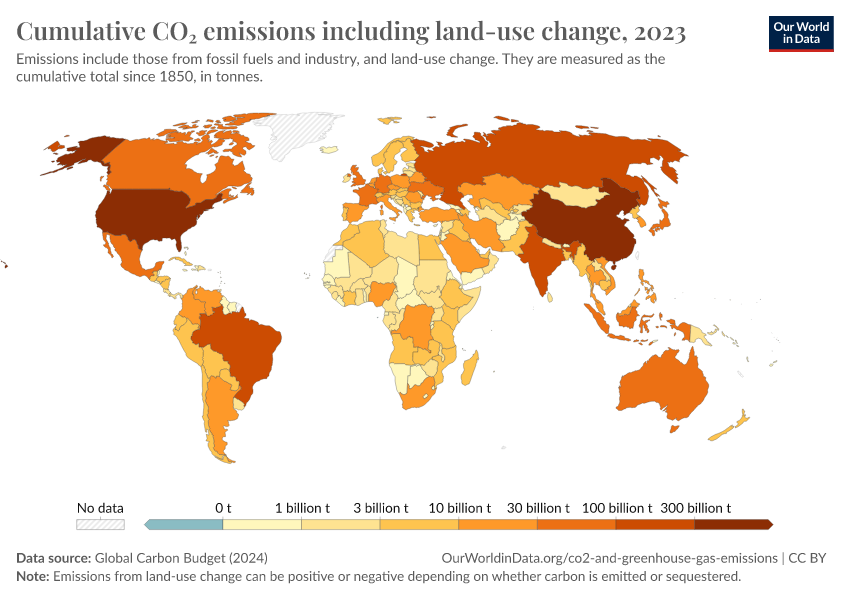Cumulative CO₂ emissions including land-use change

What you should know about this indicator
- This data is based on territorial emissions, meaning the emissions produced within a country's borders, but not those from imported goods. For example, emissions from imported steel are counted in the country where the steel is produced. To learn more and look at emissions adjusted for trade, read our article: How do CO₂ emissions compare when we adjust for trade?
- Emissions from international aviation and shipping are not included in the data for any individual country or region. They are only counted in the global total.
What you should know about this indicator
- This data is based on territorial emissions, meaning the emissions produced within a country's borders, but not those from imported goods. For example, emissions from imported steel are counted in the country where the steel is produced. To learn more and look at emissions adjusted for trade, read our article: How do CO₂ emissions compare when we adjust for trade?
- Emissions from international aviation and shipping are not included in the data for any individual country or region. They are only counted in the global total.
Sources and processing
This data is based on the following sources
How we process data at Our World in Data
All data and visualizations on Our World in Data rely on data sourced from one or several original data providers. Preparing this original data involves several processing steps. Depending on the data, this can include standardizing country names and world region definitions, converting units, calculating derived indicators such as per capita measures, as well as adding or adapting metadata such as the name or the description given to an indicator.
At the link below you can find a detailed description of the structure of our data pipeline, including links to all the code used to prepare data across Our World in Data.
Notes on our processing step for this indicator
- Global emissions are converted from tonnes of carbon to tonnes of carbon dioxide (CO₂) using a factor of 3.664. This is the conversion factor recommended by the Global Carbon Project. It reflects that one tonne of carbon, when fully oxidized, forms 3.664 tonnes of CO₂, based on the relative molecular weights of carbon and oxygen in CO₂.
- Emissions from the 1991 Kuwaiti oil fires are included in Kuwait's emissions for that year.
Reuse this work
- All data produced by third-party providers and made available by Our World in Data are subject to the license terms from the original providers. Our work would not be possible without the data providers we rely on, so we ask you to always cite them appropriately (see below). This is crucial to allow data providers to continue doing their work, enhancing, maintaining and updating valuable data.
- All data, visualizations, and code produced by Our World in Data are completely open access under the Creative Commons BY license. You have the permission to use, distribute, and reproduce these in any medium, provided the source and authors are credited.
Citations
How to cite this page
To cite this page overall, including any descriptions, FAQs or explanations of the data authored by Our World in Data, please use the following citation:
“Data Page: Cumulative CO₂ emissions including land-use change”, part of the following publication: Hannah Ritchie, Pablo Rosado, and Max Roser (2023) - “CO₂ and Greenhouse Gas Emissions”. Data adapted from Global Carbon Project. Retrieved from https://archive.ourworldindata.org/20251204-133459/grapher/cumulative-co2-including-land.html [online resource] (archived on December 4, 2025).How to cite this data
In-line citationIf you have limited space (e.g. in data visualizations), you can use this abbreviated in-line citation:
Global Carbon Budget (2025) – with major processing by Our World in DataFull citation
Global Carbon Budget (2025) – with major processing by Our World in Data. “Cumulative CO₂ emissions including land-use change” [dataset]. Global Carbon Project, “Global Carbon Budget v15” [original data]. Retrieved January 5, 2026 from https://archive.ourworldindata.org/20251204-133459/grapher/cumulative-co2-including-land.html (archived on December 4, 2025).